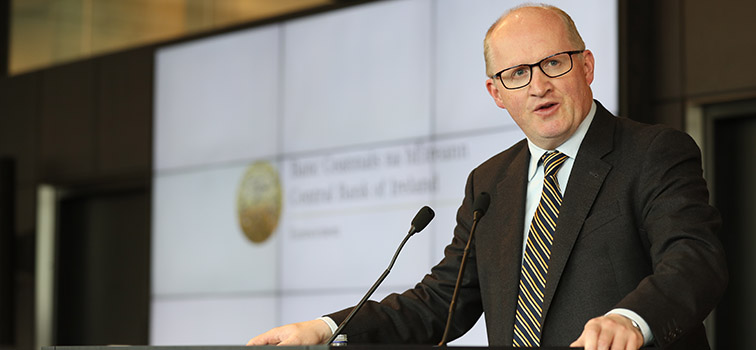The Macroeconomics of Price and Wage-Setting - Governor Philip R. Lane
19 June 2018
Speech

2018 ECB Forum on Central Banking, Sintra
- Panel Remarks
In my remarks, I will focus on three questions: (i) how should central banks respond to low inflation?; (ii) how should central banks react to headwind shocks to inflation; and (iii) how effective have been unconventional monetary policy measures in lifting inflation towards the target level?
I will discuss these questions in the context of the euro area and the monetary strategy of the ECB that has included non-standard elements (negative interest rate, forward guidance, asset purchase programme, targeted long-term liquidity refinancing operations) since the middle of 2014.
The policy package that was initially launched in Summer 2014 was a response to the below-target outlook for the inflation rate and the subdued level of aggregate demand in the euro area. If the ECB had not taken decisive action, it is possible to entertain alternative scenarios in which expectations of ultra-low inflation or even deflation took hold. An excessively-tight monetary stance could also have contributed to further recessionary impulses, especially given the vulnerability of highly-indebted groups to adverse feedback dynamics between high lending rates, low aggregate demand and high bank funding conditions in some member countries.
Accordingly, the experience of the last several years is that a phase of persistently-low inflation requires a vigorous central bank response. Praet (2018) estimates that the ECB’s package of unconventional measures will add a cumulative 1.9 percentage points to both inflation and output over 2016-2020, which has been achieved through an easing of financial conditions and the anchoring of inflation expectations. Furthermore, the probability distribution of inflation has shifted to the right, with very little weight now attached to deflation scenarios. In the absence of these non-standard measures, the inflation and output outlook for the euro area would be substantially worse.
Let me emphasise that such measures take time to operate, such that the gap between current inflation and the inflation target can only be closed gradually. During an extended period in which inflation is below its target, it is vital that a central bank is energetic and consistent in communicating its commitment to meeting its medium-term inflation target, while also being transparent about the need for patience during the convergence process. A successful communications strategy also involves publishing as much as possible in terms of the central bank’s analysis of the impact of non-standard measures, especially in view of the limited historical track record for such policies.
In addition to the role played by the considerable economic slack that remained after the 2008-2012 crisis years, temporary factors such as a phase of declining oil prices during 2014-2016 and some sectoral relative price movements (such as declines in the price of telecommunications bundles) have also contributed to below-target inflation. Considerable effort is devoted to unpicking pricing dynamics between less-volatile and more-volatile components and between more-cyclical and less-cyclical sectors, even while the target rate is appropriately measured in relation to headline inflation. As temporary and one-off factors fade away, the headline path should align with the underlying persistent component of inflation.
At one level, the distinction between the current headline inflation rate (affected by one-off factors) and the target medium-term inflation rate is well understood, since the practical reality of transmission lags means that central banks must necessarily set policy in relation to the medium term. However, if headline inflation is persistently below the target rate, this runs the risk of de-anchoring inflation expectations and can also lead to slower adjustment towards the target to the extent that there are backward-looking elements in price- and wage-setting. This reinforces the essential role played by a clear and consistent communication strategy that the central bank is intent on achieving its inflation target in the medium term and is acting through its full set of monetary policy instruments to ensure that inflation is on a path that will sustainably converge towards the target.
Returning to the 2014 debate on whether unconventional monetary instruments would prove helpful in tackling low inflation in the euro area, the accumulated evidence since then has proven the value of these measures. In a situation in which there was room for an easing in financial conditions and there was considerable economic slack, the combined impact of the different measures delivered a level shift downwards in the yield curve and a considerable reduction in lending rates. In turn, the easing in financial conditions and the commitment to the inflation target have facilitated a positive but measured pace of credit growth in recent years and a broad-based recovery in domestic activity levels across the euro area, together with a positive contribution from external demand that was especially important during 2014-2015. As noted earlier, the probability distribution for inflation has shifted rightwards and projections for inflation and output are more positive than would have been the case in the absence of these measures.
At the same time, inflation remains below target: as re-confirmed by the Governing Council at last week’s meeting, an accommodative monetary strategy will remain in place in order to underpin the ongoing adjustment path for inflation towards its medium-term target.
Acknowledgements: I thank Robert Goodhead and Shayan Zakipour-Saber for their assistance in preparing these remarks.
Reference:
Peter Praet (2018), “Assessment of Quantitative Easing and Challenges of Policy Normalisation,” Speech at The ECB and Its Watchers XIX Conference, Frankfurt, 14th March.